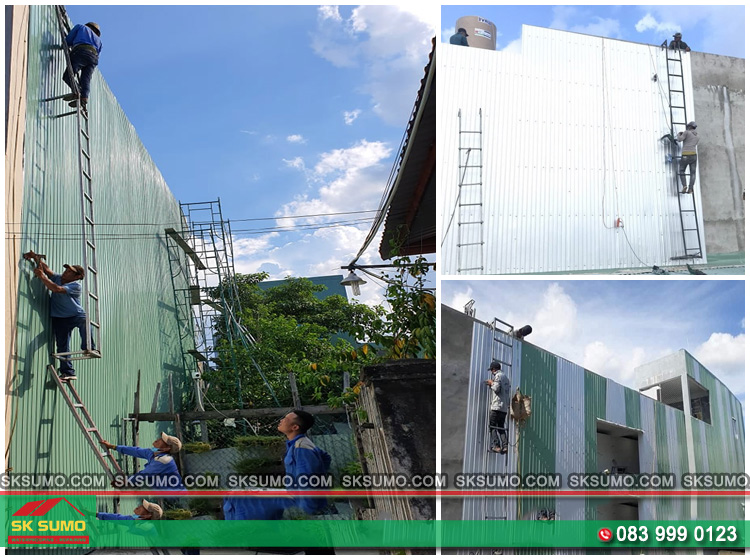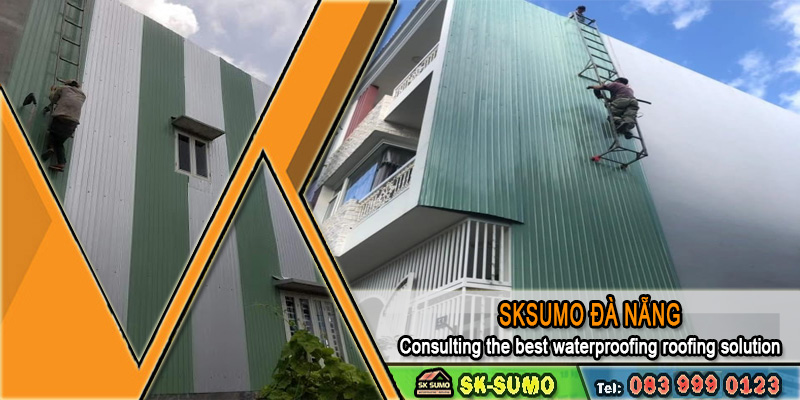Many people believe that waterproof paint alone is enough, but in reality, waterproof metal cladding delivers superior performance when applied to the right structures. This article explains its mechanism, effectiveness, cost, and how to select the right solution for each type of building.

Waterproof metal cladding involves using cold-rolled steel sheets, galvanized sheets, or insulated panels to cover exterior walls or roofs to prevent rainwater from seeping into the structure. Its mechanism relies on forming a physical barrier between the wall and the environment, combined with a fixed frame system using specialized screws for airtight sealing.
In practice, the effectiveness of waterproof metal cladding depends on sheet thickness, installation technique, and the building’s drainage design. When installed properly, the metal panels act as a “shield” that protects walls from harsh weather, reduces paint peeling, and prevents mold buildup.
In harsh climates like Central Vietnam-especially in Đà Nẵng - cold-rolled and insulated panels are increasingly popular due to intense heat and heavy rainfall. This solution keeps buildings dry, reduces indoor temperatures, and suits coastal urban environments.
Currently, the three most widely used sheet types are:
Choosing the right material directly determines whether waterproof metal cladding is effective, as each type varies in heat resistance, reflectivity, and durability.
For long-term wall protection and temperature control, insulated panels are considered the most effective choice.
A tightly sealed metal layer blocks rainwater from touching the wall surface. Especially for west-facing or humid walls, this reduces exterior dampness by 90-95%. Compared to waterproof paint, metal cladding doesn’t age quickly under UV or heat. Real-world projects show that, when installed correctly, waterproof metal cladding remains highly effective for 5-10 years or more.
Beyond blocking water, cladding reduces solar heat absorption, maintaining a stable indoor temperature and protecting wall paint from moisture and peeling. Studies in southern Vietnam reveal that clad walls stay 4-6°C cooler than exposed ones, proving the method’s clear efficiency.
Vietnam’s hot, humid climate accelerates corrosion, so durability depends on surface coating and thickness. Cold-rolled sheets 0.4-0.5 mm thick last up to 15 years, while galvanized ones last 7-8. In coastal or rainy areas, AZ100 or AZ150 coatings are essential for long-term waterproof performance.
Thanks to these advantages, waterproof metal cladding is a top choice in humid regions or for aged walls.
While effective, it can reduce aesthetics if not color-matched or designed neatly. When installed too close to the wall, trapped humidity may cause condensation. Adding ventilation gaps or moisture-proof padding helps maximize performance.
Avoid for small or highly decorative facades like townhouses or villas. In areas without direct rain exposure, waterproof paint is more cost-efficient. For severely degraded walls, fix the base first to ensure effectiveness.
|
Criteria |
Waterproof paint |
Metal cladding |
|---|---|---|
|
Durability |
3-5 years |
10-20 years |
|
Water resistance |
Moderate |
Excellent |
|
Thermal insulation |
Low |
Good |
|
Cost |
Low |
Medium-High |
|
Maintenance |
Frequent |
Minimal |
|
Aesthetics |
High |
Depends on design |
The table shows that effectiveness depends on project goals-metal cladding excels in long-term protection.
In such cases, metal cladding is the most practical, dual-purpose waterproof and cooling solution.
Experts recommend combining waterproof paint inside with cladding outside. This dual-layer system blocks water from both directions, doubling wall lifespan compared to single-layer methods.
These walls face harsh sun and rain, leading to paint peeling, mold, and deep seepage. Here, cladding with cold-rolled steel effectively reduces surface temperature by 5-7°C while preventing cracks and leaks.
For boundary walls, where repainting is difficult, exterior cladding is a fast, durable alternative.
Constantly exposed zones like roofs and balconies are prone to leaks. Insulated cladding prevents water pooling and lowers indoor heat. Many homeowners who switched from waterproof paint to metal confirm its superior results.
In central and highland regions with heavy rainfall, 0.45 mm galvanized panels are cost-effective, durable (10 years+), and easy to maintain. For large-scale structures, cladding minimizes downtime and repainting costs.

Effectiveness depends on material standards:
PU-insulated and colored cold-rolled panels are the best options for homes, offering waterproofing and heat control.
To ensure full waterproofing:
Proper installation maximizes system lifespan and prevents leaks.
Inspect every 6-12 months. Clean with water or soft cloths; avoid harsh chemicals. Replace scratched or rusty screws immediately. Regular maintenance keeps panels effective for 15-20 years.
For long-term damp walls, apply cement-based or bitumen waterproof coating first, then add metal cladding. This dual system completely blocks water infiltration.
For cracked or flaking walls, clean and fill gaps with waterproof mortar, dry for 24 hours, then install panels. Skipping this step reduces effectiveness.
Spray anti-fungal solution before installation and use PU-insulated or fiberglass layers to stabilize humidity and temperature. These details ensure long-term success.
Install during the dry season when walls are completely dry-this ensures strong adhesion and prevents future leaks.
Average cost: 350,000-650,000 VND/m² depending on material. Though higher than paint initially, it lasts 3-4 times longer and cuts repair costs by up to 60%.
Combining cold-rolled or PU-insulated panels with proper techniques creates a long-term waterproof, energy-saving, and aesthetic solution for both homes and factories.
In conclusion, waterproof metal cladding is effective-when materials, installation, and placement are chosen correctly. It keeps buildings dry, cool, and cost-efficient in Vietnam’s challenging climate.
No, unless it affects the building structure or façade. Notify local authorities if unsure.
Only for small areas. For full waterproofing and safety, hire professionals with the right tools and materials.
No. Using cold-rolled or PU-insulated sheets actually lowers indoor temperature by 4-6°C and reduces humidity.
Yes, apply metal-specific paint for extra durability, rust protection, and better heat reflection.
Once a year-clean moss, tighten screws, and reseal joints to extend lifespan up to 15-20 years.